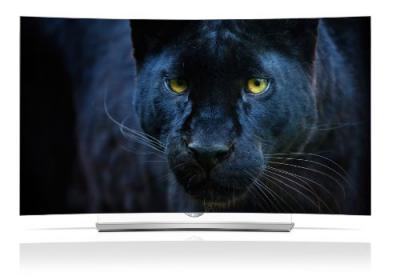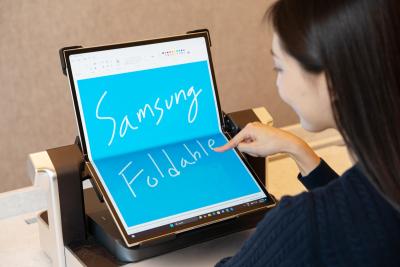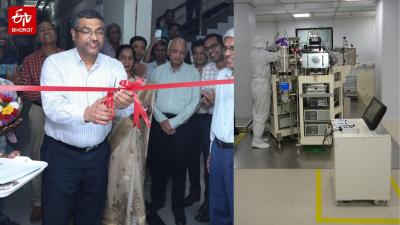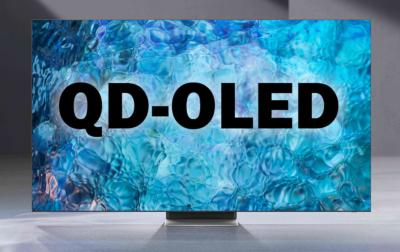OLED TV: Introduction and Industry News
What is an OLED TV?
OLED TVs use a display panel technology called OLED (Organic Light Emitting Diodes). Compared to LCDs, OLEDs offer an improved image quality, and are brighter, more efficient, and thinner. Simply put, OLED TVs deliver the best picture quality ever!

OLED TV technology
Each pixel in an OLED TV emits light on its own (in fact each pixel is made from 3 different OLEDs, red, green and blue). OLEDs are truly emissive devices with a simple design which gives them many advantages over current LCD technology:
- High contrast: in OLEDs we have true blacks as when a pixel is off it does not emit any light. In LCDs, the backlighting is always on and so true blacks are impossible to achieve. Even when compared to the latest high-end mini-LED backlit LCDs, the contrast of OLEDs is superior.
- High refresh rates: OLEDs can switch on and off much faster than LCDs.
- Better power consumption: OLEDs only consume light on lit pixels - as opposed to LCDs who always need to use the backlighting. The power consumption of OLEDs depends on the image shown, but in most cases OLEDs will be more efficient than LCDs.
- Flexibility: the simple design of OLEDs enables next-generation flexible, bendable, foldable and even rollable displays.
Click here for a more in-depth comparison between LCDs and OLEDs.
OLED TVs on the market - what can you buy today?
The leading OLED TV panel producer is LG Display - making panels ranging from 42-inch to 97-inch. These OLEDs offer the best image quality of all TVs on the market today. LGD is offering its OLED panels to many companies, including LG Electronics, Sony, Vizio and Panasonic.

In 2022 Samsung joined LGD and started to produce its own OLED TV variant, called QD-OLED (which is based on blue OLED emitters and quantum dots color conversion technology). QD-OLED panels offers a superb image quality, but Samsung's production capacity is smaller than LG's.
Today close to 10 million OLED TVs ship every year, from many TV producers (including LG, Samsung, Sony, Panasonic, Philips and more), offering a wide range of OLED TV models. Click here for the latest OLED TVs on the market.
Reviews of OLED TVs are terrific, and most experts and consumers agree that these OLED TVs are the best TVs ever produced - with virtually perfect image quality and beautiful form factors.
Direct Emission vs WRGB / QD-OLED
The most straightforward OLED architecture uses 3 color OLED sub-pixels (Red, Green and Blue) to create each 'pixel'. This is referred to as a direct emission OLED, and is the design used in mobile OLED displays (for example those used in Apple's latest iPhones, iPads and Watches). But direct-emission OLEDs are not available in TV sizes (not yet, anyway).
For its OLED TVs, however, LG Display uses a different architecture, called WRGB (or WOLED-CF) which uses four white OLED subpixels (each created by using both blue and yellow OLED emitters) with color filters on top (RBG and W). The WRGB technology (developed by Kodak many years ago and now owned by LG Display) was found to be easier to scale-up for large-area OLED production, although it suffers from lower efficiency and more complicated design compared to direct-emission TVs .
As we stated, Samsung's OLED TV architecture is based on blue OLED emitters and quantum-dots color conversion layers. In terms of performance, this architecture seems to be rather similar to LGD's WRGB panels.
Further reading
- Introduction to OLEDs
- A list of all OLED TVs on the market
- OLED vs LED TVs
- Flexible OLEDs
- The OLED Toolbox, OLED industry guides, insights, data and more!
LG Display's latest WOLED panels reach 4000 nits, the company details the META 3.0 technology behind it
Last week LG Electronics officially launched its 2025 OLED TV range, where some of the high-end models reaching 4,000 nits. LG Display today unveiled the technology behind these new OLED displays.
LGD's so-called META 3 WOLED panels (which are the company's 4th-gen WOLEDs) achieve 33% higher brightness to each a maximum of 4,000 nits. The new panels adopt a new stack structure that has two layers of blue emitters and two more layers, one with red emitters and one with green emitters. LGD refers to this architecture as a "Primary RGB Tandem structure".
Counterpoint: OLED shipments grew 28% in Q3 2024, driven by higher demand for smartphones, TVs and laptops
Counterpoint (DSCC) says that OLED panel revenues increased 28% in Q3 2024, and the company expects revenues in all of 2024 to grow 16% from 2023, mainly driven by growth in smartphones, TVs and IT applications.
In terms of unit shipments, Q3 2024 saw a 34% increase from Q3 2023. Shipments of OLED smartphone panels increased 43% from 2023 (and 24% in revenues). OLED TV shipments grew 48% in the quarter (36% increase in revenue). The largest increase came from laptop OLED panels that more than doubled (108%) in shipments in Q3.
Samsung Electronics announced its 2025 OLED TV range
Samsung Electronics announced its 2025 OLED TV range, with three different series. The TVs use a combination of SDC's QD-OLED panels (latest generation that reaches 4,000 nits) and LGD's OLEDs.
The top of the range is the S95F, Samsung's flagship 2025 TV, that will be available in 55", 65", 77" and 83" sizes. The S95F offers 4K 165hzQD-OLED panels (except the 83-inch model which uses LG's WOLEDs, apparently). The S95F TVs use Samsung's new NQ4 AI Gen3 video processor.
LG Electronics unveiled its 2025 OLED TV range
LG Electronics officially launched its 2025 OLED TV range, with 4 different series. The higher-end G5 and M5 models adopt a new WOLED panel design that increases the number of stacks to 4 (previous models used 3 stacks) which increases brightness and efficiency. Interestingly, none of these TVs use a microLens array (MLA).
So LG's OLED M5 is the company's flagship wireless 4K 144Hz OLED for 2025. The M5 will be offered in 65", 77", 83" and 97" sizes. The OLED G5 is the second top-of-the-line TV, with 4K 165Hz panels (144Hz on the 48-inch and 97-inch models), offered in a wide range of sizes (48", 55", 65", 77", 83" and 97").
Samsung Display shows new OLED technologies at CES 2025
Samsung Display is set to show new OLED technologies at CES 2025, including new foldable display, rollable ones, automotive displays, next-gen QD-OLED panels and more.
So first up, Samsung will be showing a 18.1 foldable OLED display (which it says is the world's largest). This panel is suitable for IT devices - to enable devices that combine tablet, laptop and monitor devices into one. When folded, this display is 13.1" in size.
India inaugurates a new AMOLED research center at IIT Madras
The Indian Institute of Technology Madras (IIT Madras) has inaugurated a new research center dedicated for the development of AMOLED technologies. The new AMOLED Research Centre (ARC) is a national centre of excellent that is funded by the Government's Ministry of Electronics and Information Technology (MeitY), by the Indian Defence Research and Development Organisation (DRDO), and Tata Sons.
The goal of this new center is to help India's display manufacturing industry. It will focus on AMOLED displays for wearables, smartphones, and tablets. Researchers at the ARC will also engage in research into OLED TVs, OLED lighting and OPVs.
LG starts offering its transparent Signature OLED T TV with a $60,000 price tag
LG announced that it is starting to ship its transparent wireless Signature OLED T TV with a $59,999 price tag. The TV can be ordered from LG directly or from Best Buy.
LG's Signature OLED T is a 77" 4K wireless transparent OLED TV that can change from a transparent mode to a black-background mode (via a raised black contrast film) in which it operates just like a normal OLED TV. The OLED T is powered by LG's Alpha 11 AI processor, and uses LG's Zero Connect box which makes it almost completely wireless (except the power).
Omdia: large-area OLED panel shipments to grow 116.5% in 2024, and 32.7% in 2025
Omdia estimates that shipments of OLEDs over 9-inch in size (which Omdia defines as large-area OLEDs, although most companies will refer to these sizes as medium-sized OLEDs) will increase 116.5% in 2024, and will rise a further 32.7% in 2025.
This growth is driven by increasing demand for OLED monitors, tablets and laptops.
Applied Materials launches a maskless OLED production technology, to support 8-Gen high efficiency OLED deposition and encapsulation
Applied Materials announced a technology, branded as MAX OLED that enables OLED display production on large glass substrates, aiming to provide a cost-effective solution to produce TV and TV displays. Applied developed and patented a new OLED pixel architecture and a "dramatically different manufacturing approach" that the company says enables brighter, clearer, more energy-efficient and longer-lasting.
Applied's new MAX OLED systems can scale from 6-Gen substrates to 8-Gen substrates, supporting the new wave of IT OLED production lines. Applied says that its new solution has strong customer interest - and already achieved repeat orders from several leading display makers (see below). Specifically, Applied announced that it will supply an R&D system to Samsung Display that will test the new production technology for its AMOLED and QD-OLED production technologies.
Samsung may launch 83-inch QD-OLED TVs in 2025
According to reports, based on information found on a parts database, Samsung Electronics is getting ready to launch a 83-inch QD-OLED TV in 2025. The 83-inch panel will be introduced in the 2025 QD83S9F TV, and Samsung us likely to use both WOLED and QD-OLED panels in this TVs as was done in the 2024 S90D.
This is interesting news. Samsung's QD-OLED technology is under pressure and it is not clear whether Samsung intends to continue investing in it, and expanding production capacity. It seemed as if SDC is mostly focused on gaming monitors, but perhaps now it is also expanding its TV panel range, which is a welcome change.
Pagination
- Page 1
- Next page











